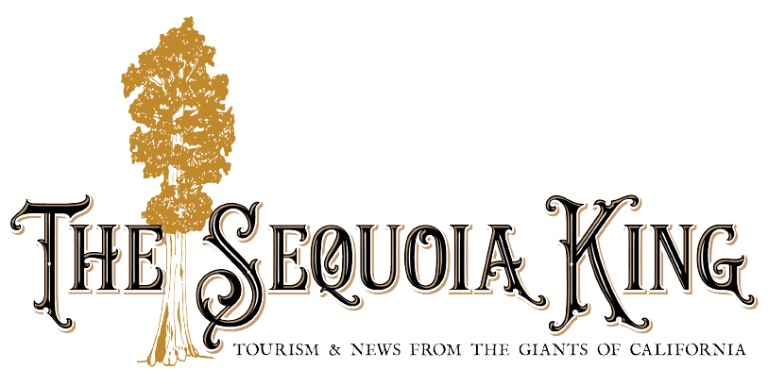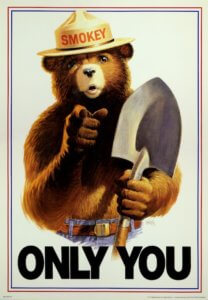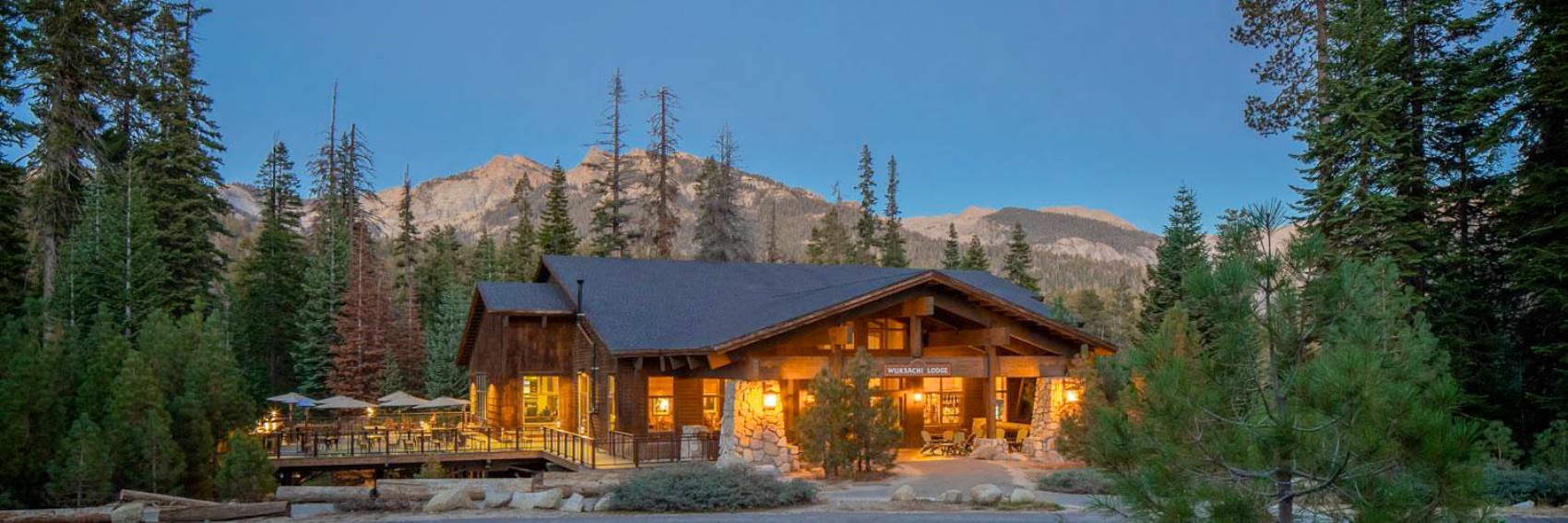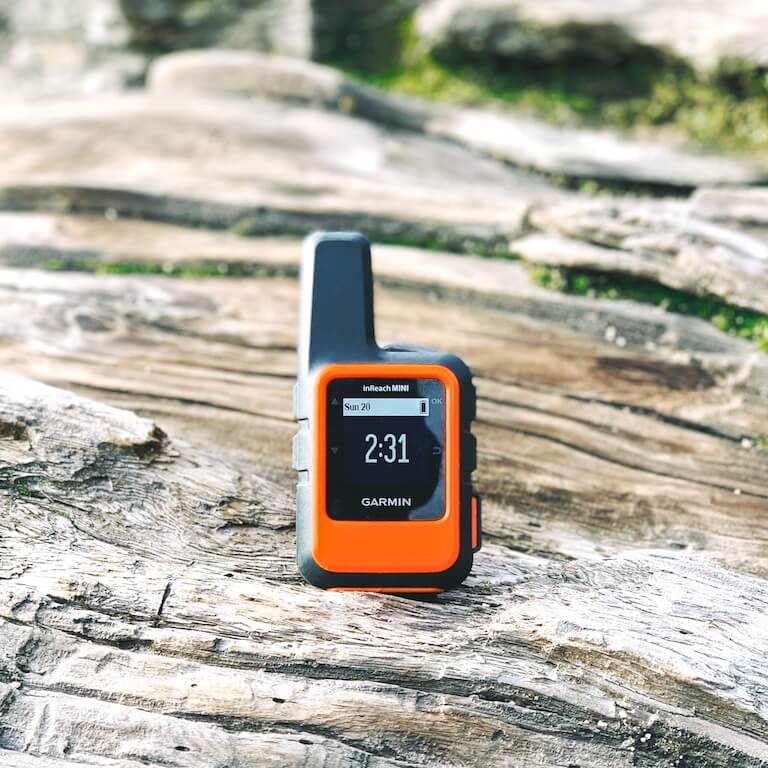Smokey Bear History

The guardian of our forest has been a part of the American scene for so many years, it is hard for most of us to remember when Smokey Bear first appeared. Dressed in a ranger’s hat, belted blue jeans and carrying a shovel, he has been the recognized wildfire prevention symbol since 1944. Today, Smokey Bear is a highly recognized advertising symbol and is protected by Federal law (PL 82-359, as amended by PL 93-318). He even has his own private zip code 20252.
To understand how Smokey Bear became associated with wildfire prevention, we must go back to World War II. On December 7, 1941, Japanese planes attacked Pearl Harbor. The following spring, in 1942, a Japanese submarine surfaced near the coast of Southern California and fired a salvo of shells that exploded on an oil field near Santa Barbara, very close to the Los Padres National Forest.
Americans throughout the country were shocked by the news the war had now been brought directly to the American mainland. There was also fear that enemy incendiary shells exploding in the timber stands along the Pacific Coast could easily set off numerous raging forest fires in addition to those already being caused by people. Protection of these forests from uncontrolled fire became a matter of national importance, and a new idea was born.
If people could be urged to be more careful, perhaps some of the fires could be prevented.
Forest fires caused by people were nothing new. For many years, the nation had known that forest fires presented a serious threat. As early as 1902, there was a standard General Land Office forest fire warning poster that gave some guidelines for keeping fires under control. In 1939, a poster showing a forest ranger who looked like Uncle Sam pointing to a raging forest fire stated “Your Forest-Your Fault-Your Loss.”
Statistics showed that nine out of ten of the fires were person-caused and, thus, preventable. With this in mind, in 1942 the Forest Service organized the Cooperative Forest Fire Prevention Program with the help of the Wartime Advertising Council. The Wartime Advertising Council was composed of people experienced in the business of advertising who donated their talent to the U.S. Government to get important messages to the people.
Posters and slogans were created through the Wartime Advertising Council, including “Forest Fires Aid the Enemy,” and “Our Carelessness, Their Secret Weapon.” By using catchy phrases, colorful posters and other fire prevention messages, the CFFP Program encouraged people to prevent accidental fires and help with the War.
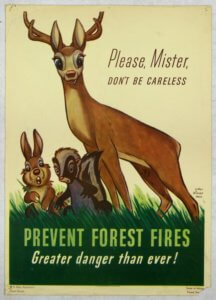
Bambi Before the Bear
Walt Disney’s motion picture “Bambi” was produced in 1944, and Disney authorized the CFFP Program to use his creation on a poster. The Bambi poster was a success and proved that using an animal as a fire prevention symbol would work. Bambi could not be used in subsequent campaigns, because it was on loan from Walt Disney studios for only one year. The Forest Service needed to find an animal that would belong exclusively to the Cooperative Forest Fire Prevention Program. It was finally decided that the Nation’s fire prevention symbol should be a bear.
“Only YOU Can Prevent Forest Fires” – Smokey Bear
On August 9, 1944, the new fire prevention symbol was agreed upon by the Forest Service and the Wartime Advertising Council. Artist Albert Staehle was asked to paint the first poster of Smokey Bear. It showed a bear pouring a bucket of water on a campfire. Smokey Bear soon became very popular and his image began appearing on fire prevention materials.
“Only YOU Can Prevent Forest Fires” was first used as a slogan in 1947. Jackson Weaver, a noted radio personality of Washington, D.C. provided the original “voice” of Smokey Bear.
The Little Smokey Bear
One spring day in 1950 in the Capitan Mountains of New Mexico, an observer in one of the fire towers spotted smoke and called the location into the nearest Ranger Station. The first crew to arrive discovered a major fire being swept along by strong winds. Word spread rapidly and more crews were called to help. Forest rangers, Army soldiers, New Mexico State Game and Fish Department employees and civilian volunteers worked together to control the raging fire. During one of the lulls in the firefighting, there was a report of a lonely cub seen wandering near the fire line.
The little cub had been caught in the path of the fire. He had taken refuge in a tree that was now nothing but a charred, smoking snag. His climb had saved his life but left his paws and hind legs badly burned. The firefighters removed the little bear cub from the burned tree, and a rancher, who had been helping the firefighters, agreed to take the cub home. The cub needed veterinary aid and was flown to Santa Fe where the burns were treated and bandaged.
The news about the little bear spread swiftly throughout New Mexico. Soon the United Press and Associated Press picked up the story and broadcast it nationwide. Many people inquired about the little bear’s progress. The State Game Warden wrote an official letter to the Chief of the Forest Service, offering to present the cub to the agency with the understanding that the small bear would be dedicated to a publicity program for fire prevention and wildlife conservation.
The go-ahead was given to send the bear cub to Washington, D.C. Once there, he found a home at the National Zoo and became the living symbol of Smokey Bear. Smokey died in 1976 and was returned to Capitan, New Mexico, where he is buried in the State Historical Park.
Smokey Costumes
In November 1951, the first Smokey Bear costume was fabricated by Wass of Philadelphia for the Virginia Division of Forestry. Its success prompted the US Exhibit Service to make additional costumes. Today Smokey Bear costumes are only made by licensed contractors and are only sold to Federal and State firefighting agencies. Any other sales must be approved in writing.
By 1952, the Smokey Bear symbol was sufficiently established to attract commercial interest. Public Law 82-359 was enacted to take Smokey Bear out of public domain and place him under the control of the Secretary of Agriculture. An amendment to that Act, PL 93-318, passed in 1974, enabled commercial licensing and directed that fees and royalties be used to promote forest fire prevention. Thousands of items have been licensed under this authority over the years.
The Junior Forest Ranger program was also started in 1952. This activity encouraged children throughout the nation to write to Smokey Bear expressing their interest in fire prevention. In reply they would receive a Junior Forest Ranger Kit and other fire prevention materials. By 1965, the volume of mail for this activity was so high that Smokey Bear received his own Zip Code, 20252. The program has been recently redesigned to keep pace with state-of-the-art educational techniques.
The CFFP Program rode through the 1970s and into the 1980s with lessened momentum. Smokey Bear’s early years had been easy, because it was a simpler time when his familiar message was one of the few being pushed. However, intense competition, global markets and rapid technological changes emerged, and Smokey Bear found it difficult to compete for a share of the public’s attention.
In 1984, Smokey Bear’s 40th Birthday was celebrated, and the first day issue of his postage stamp took place in Capitan, New Mexico. In 1987, Smokey Sports was launched as a new component of the CFFP Program. “National Smokey Bear Day” was conducted with all major league baseball teams in the United States and Canada. The decade of the 1990s opened the door for Smokey Bear’s revitalization and revival by celebrating his 50th birthday with a nationwide celebration engaging in high visibility activities and events.
Smokey Bear’s message of “Only You Can Prevent Forest Fires” was changed to “Only You Can Prevent Wildfires” in 2001. The term wildfire applies to any unwanted outdoor fire. The new tagline was created by The Advertising Council, along with the US Forest Service and the National Association of State Foresters (NASF), in response to the recent and rampant outbreak of wildfires, wildfires happening in grasslands and other areas than forests, to differentiate between human- caused wildfires and beneficial prescribed fires and in an effort to make Smokey Bear’s message of forest conservation more contemporary.
In 2004, Smokey Bear celebrated his 60th Birthday with a special logo incorporating the line “60 Years of Vigilance.” At a high-profile ceremony in Universal City, CA, Smokey Bear blew out his candles while children of wildland fire fighters sang Happy Birthday to him. At the celebration Smokey Bear was presented with a giant Hallmark Birthday card, a birthday cake and a personalized gift-wrapped shovel.
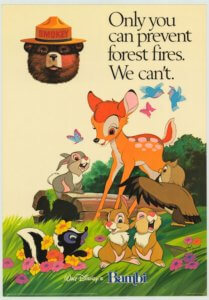
To renew the important message of wildfire prevention to Americans, Smokey Bear enlisted the help of Bambi in 2004. Smokey Bear has an experienced partner in Bambi, who was actually the first face of the forest fire prevention message in 1942. Advertising agency Foote Cone and Belding (FCB), who has worked on the campaign since the beginning, featured Bambi on posters to remind us to be careful with our forests. TV Public Service Announcements (PSAs) featuring Bambi were created, and asked us all to “Don’t Let Our Forests Become Once Upon a Time.”
Smokey Bear continued to reach new generations by entering the world of social media around 2008 with his own Facebook page, Twitter, Instagram and Flickr accounts, blog, and a mobile app version of his website, smokeybear.com. In 2012, American astronaut, Joseph Acaba raised awareness of the importance of wildfire prevention by choosing Smokey Bear as his crew mascot to the International Space Station.
Smokey’s Impact
Has all this effort to prevent human-caused wildfires had an effect? During the 1930s, the average annual number of wildfires was 167,277. During the 1950’s, the average yearly number of wildfires was down to 125,948. During the 1990’s the number was 106,306. This number does include lightning started wildfires, but the trend is definitely going down.
From 2001 through 2014, almost 63,000 wildfires occurred each year from human carelessness, and those fires burned an average of 2,560,000 acres each year. In 2016, data showed just under nine out of ten wildfires were still caused by humans nationally. Considering population growth in the United States and the increase of outdoor recreation users and people living next to and within the Wildland Urban Interface (WUI), this is actually improvement. We still have a lot of work to do. Children need to hear and learn about Smokey Bear and his wildfire prevention message, and adults need to be continually reminded of the need to prevent human-caused wildfires from equipment use, dragging chains, parking on dry grass, backyard debris burning, and of course, campfires.
Credit
For more information visit: http://www.smokeybear.com/
The Cooperative Forest Fire Prevention (CFFP) Program, commonly known as the Smokey Bear Program, was created to maintain public awareness of the need to prevent human-caused wildfires. It is managed by the US Forest Service in cooperation with the Advertising Council, Inc. (Ad Council) and the National Association of State Foresters (NASF).
Used from the Smokey Bear Guidelines, July 2018.
https://smokeybear.com/guidelines/SmokeyBearUseGuidelines.pdf
